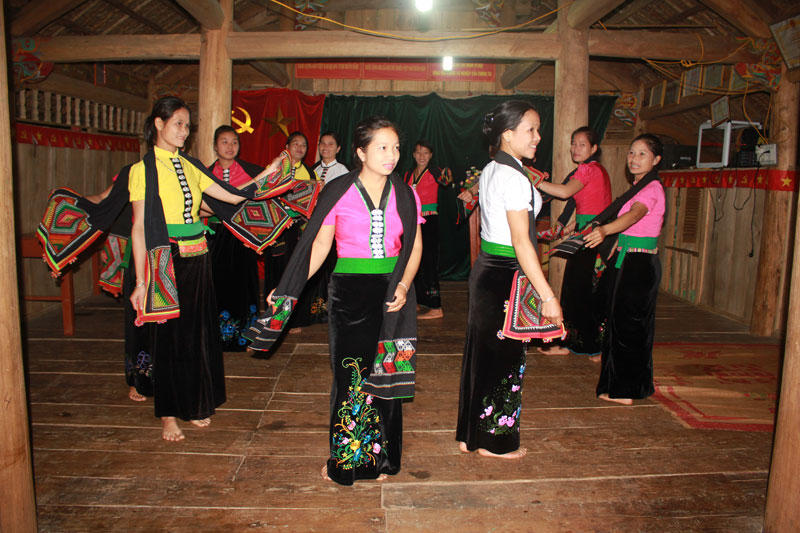
(HBO) - Tay ethnic people make up 40.57% of the 5 ethnic groups living together in Da Bac district. In the modern life rhythm, Tay ethnic culture of costumes, writing, customs and traditions are always preserved, especially the traditional costumes.

The performance team of Na Man hamlet, Muong Chieng commune (Da Bac) in traditional Tay ethnic costumes.
Men's costumes with shirts, pants, headscarves, sashes and especially the shaman's costumes also have their own beauty hidden in every detail. The men's shirts are usually long down to the waist, the neck stands about 3 cm high, cuts the chest and installs with a cloth button. The material made from self-woven cotton fabric, or black indigo with tight and narrow sleeves. In the past, men wore buttoned shirts on their shoulders and on the right flank, leaving their long hair tufts behind their necks. Today there is a little bit change with their chest skirts because the men often have the short hair. Accompanying the shirt is a wide and standing tube pants, made of white or indigo green cloth. When wearing, the waistband is tied in front of the belly and it is positioned with a cloth, called a sash with a natural color of divine flower or light pink. However, men often use sashes when going to festivals or in performing shows.
Women's costumes are more sophisticated with three types of shirts. They include short-sleeved shirts, short-sleeved tops with chestless buttons and long-sleeved shirts. They also use head scarfs, bibs, skirts and silk belts. The highlight of the dress is a tight-fitting short-sleeved shirt with a round collar and a chest split from the collar down to the skirt waistband. There is a pair of double silver butterflies or cicadas. There are odd pairs of buttons on short-sleeve like five pairs, seven pairs or nine pairs. The material is often thin fabric, sewn by the skillful hands of the Tay ethnic women. Coming along with a shirt is a bib. It is just like a pink or black short-sleeved with arnicas on the neck. The pure black dress or indigo blue consists of two types of embroidered skirt waistband and submerged flower skirt waistband. The Pieu scarf of all kinds of motifs shows the cultural characteristics, and also shows the skillful and delicate embroidery skills of the Tay ethnic women. Together with the outfit there are silk straps and jewelry such as necklaces, bracelets, earrings, gold or silver rings.
The People’s Committee of Lac Son district held a ceremony on April 28 to receive the provincial relic certificate for the ancient rock carving site at Suoi Co stream, located in My Thanh commune.
A special music show titled "The country is in the fullness of joy” has been held at Hoa Binh Square in Hoa Binh city in celebration of the 50th anniversary of the liberation of the South and national reunification (April 30, 1975–2025).
The People's Committee of Lo Son commune, Tan Lac district, has organised the local annual traditional stream fishing festival on April 19 - 20.
As a land deeply intertwined with human history and Vietnam’s millennia-long journey of nation-building and defence, Hoa Binh is often revered for its epic tales and legends.
Residents of Hoa Binh boast a rich cultural identity, reflected in their unique language, traditional attire, customs, and folk melodies – described as "sweet as honey, clear as a mountain stream.”
Lac Son district’s Vu ban town held the 2025 Truong Kha temple festival on April 12–13 (the 15th–16th days of the third lunar month). Since its revival in 2019, the festival has been organised every three years, preserving valuable intangible heritage while meeting the community’s cultural and spiritual needs.



